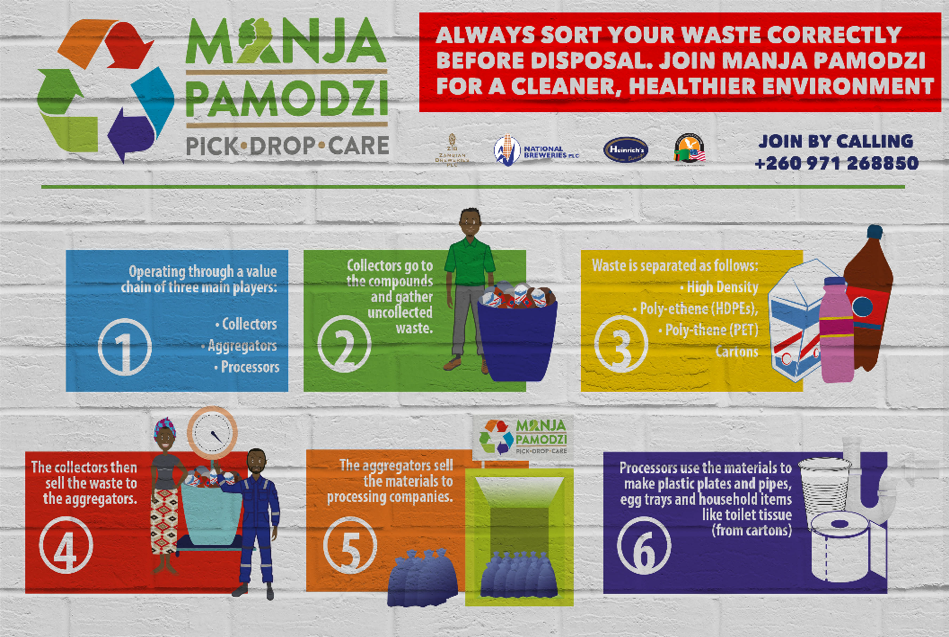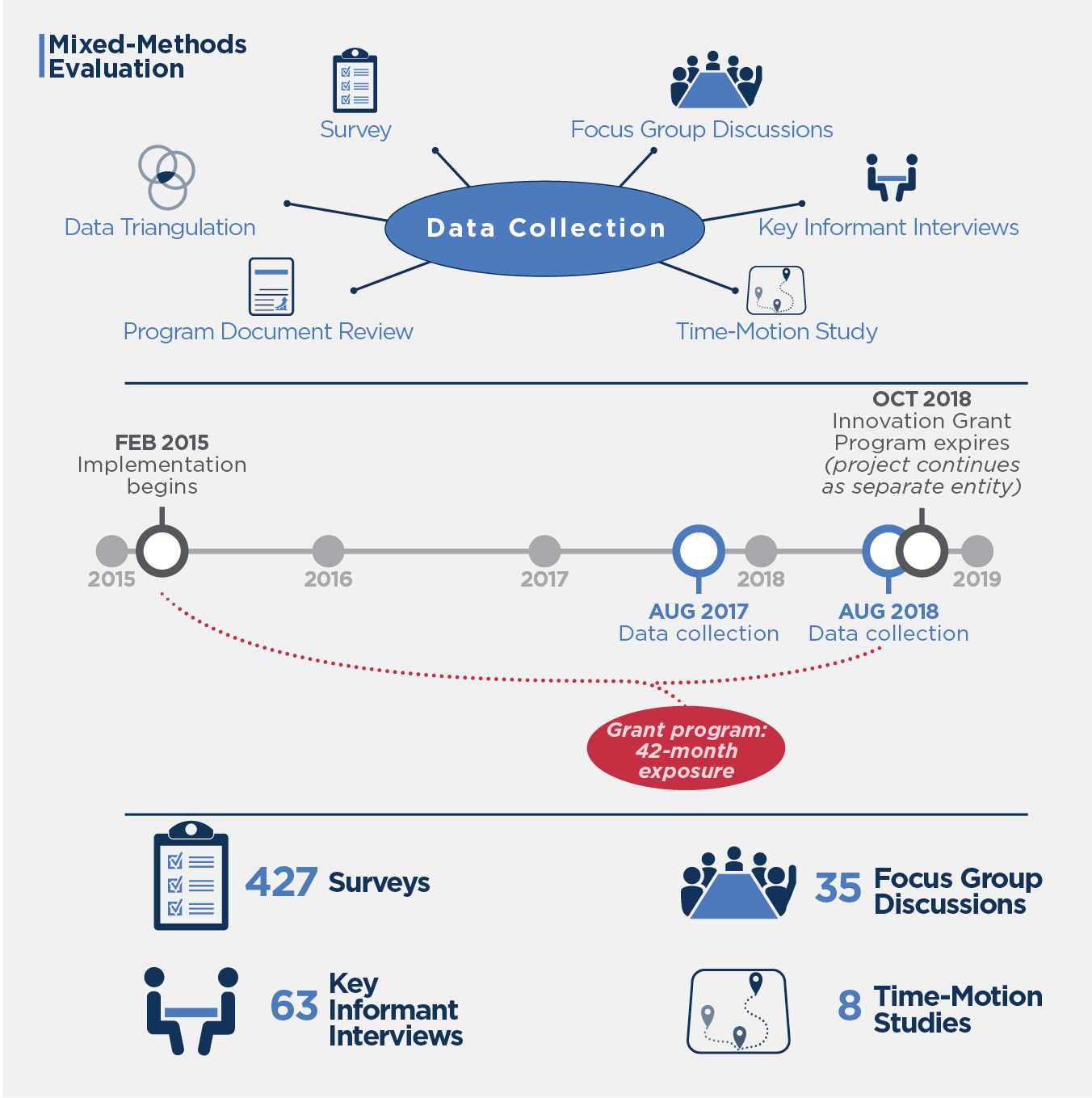Program Overview
MCC’s $355 million Zambia Compact (2013–2018) funded the $6 million Innovation Grant Program, an initiative to support innovative opportunities and partnerships in the water, sanitation, and solid waste management sectors. Zambian Breweries’ Manja Pamodzi program, a grantee under the program, aimed to create a sustainable recycling value chain in Lusaka, reduce waste, and improve the livelihood of waste collectors and aggregators.Evaluator Description
MCC commissioned the American Institutes for Research to conduct an independent performance evaluation of Zambian Breweries’ Manja Pamodzi program, which was funded through the MCC Zambia Compact. Full report results and learning: https://data.mcc.gov/evaluations/index.php/catalog/235.
Key Findings
The Manja Pamodzi Waste Collector Experience
- Waste collectors noted some challenges with the program, including low pay and lack of personal protective gear.
- Waste collectors who amassed more recyclable waste saw the greatest economic gains.
The Manja Pamodzi Waste Aggregator Experience
- Aggregators, who receive waste gathered by collectors and deliver it to processors, faced challenges transporting waste to processing sites, retaining waste collectors, and paying waste collectors in a timely manner.
- Aggregator performance varied widely, with some aggregators regularly exceeding waste aggregation goals and others struggling to accumulate enough waste to cover operational costs.
- Zambian Breweries faced challenges recruiting female aggregators.
The Manja Pamodzi Processor Experience
- Processors noted that aggregator deliveries were often unpredictable and that the waste received was not always the correct type.
- Processors would have liked to receive more waste under Manja Pamodzi than what they received.
Waste Accumulation in the Environment
- Respondents believed that Manja Pamodzi reduced waste, risk of cholera, and drain blockage in their communities.
Evaluation Questions
The performance evaluation of the Manja Pamodzi program examined research questions based on six main program processes: (1) the startup process, (2) the community campaign and outreach process, (3) the collector experience, (4) the aggregator experience, (5) the processor experience, and (6) waste in the environment. A subset of the evaluation questions includes the following:- 1 What is waste collectors’ experience collecting recyclables?
- 2 What challenges do aggregators face operating their sites?
- 3 Are processors able to receive enough sorted plastic and paper?
- 4 What is the perceived impact of the program on waste accumulation?
Detailed Findings
The Manja Pamodzi Waste Collector Experience

Because of frequent turnover among collectors, aggregators were reluctant to give them personal protective equipment (PPE) until they demonstrated a commitment to the program, which had implications for collectors’ safety and productivity. Fewer female collectors than male collectors received key PPE items, even though women were overrepresented as waste collectors.
The Manja Pamodzi Waste Aggregator Experience

Manja Pamodzi Advertisement
Manja Pamodzi struggled to recruit female aggregators throughout the program. A key barrier to recruiting female aggregators was the preference for aggregators with business and waste management experience, which stopped many female candidates from applying.
The Manja Pamodzi Processor Experience
Processors overall were satisfied with their involvement in the program. Those who processed more valuable forms of waste, such as high-density polyethylene (HDPE) and low-density polyethylene (LDPE), were more likely to say that volumes increased as a result of Manja Pamodzi than those who processed paper or cardboard products. Although some processors mentioned an uptick in waste received as a result of the program, all processors reported that they would have preferred to receive much more waste under Manja Pamodzi than they did because they need to take in a sufficient volume to operate effectively. Processors faced some challenges related to inconsistent and incorrect waste deliveries from aggregators.
Waste Accumulation in the Environment
Community members in targeted areas around Lusaka perceived an overall reduction in waste in their communities as a result of Manja Pamodzi collectors, and waste collectors collected approximately 3,800 tons of recyclable material between 2015 and 2018. Residents were happy with that reduction, given the association between waste accumulation and diseases such as cholera. However, a few community members believed that only the most profitable forms of waste were reduced.MCC Learning
- Clearly define grant program key objectives and align them with implementation strategies and guidance to be conveyed to program stakeholders.
- Build on efforts to integrate gender equality into grant activities and ensure women’s representation among beneficiaries and workers under grant programs.
Evaluation Methods

Manja Pamodzi implementation commenced in February 2015, and the term of the grant agreement under the Innovation Grant Program expired in October 2018, although the program has continued to operate as a separate entity. The evaluator conducted two rounds of data collection (in August 2017 and again in August 2018) to explore how program processes changed and to identify challenges, lessons, program modifications, and program successes throughout the program period. This represents an exposure period of approximately 3.5 years for the completed grant.
2020-002-2407


